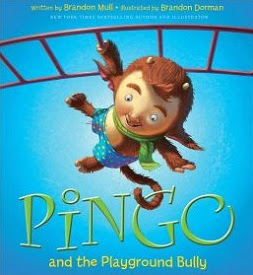Battle of the Imaginary Buddies: Pingo and the Playground Bully by Brandon Mull
IN SECOND GRADE CHAD OFTEN PLAYED WITH HIS IMAGINARY FRIEND PINGO DURING RECESS.
SEVERAL OF HIS CLASSMATES HAD IMAGINARY FRIENDS AS WELL.
All is well with Chad and his friends. Even their pretend pals have complementary superpowers: Tiffany has Awesome Girl; Gary has Sparky the Robot at his command; and Dustin had Mr. Bob, the world's smallest super guy residing in his pocket at all times. With characters like that, the four kids share some unique adventures on the playground every day.
But one day, after an bizarre battle with the Lava Monsters, the four friends begin to boast about how their "special friends" are the best, and an epic conflict arises, with each imaginary alter ego besting the others in his and her own own way. To Chad's dismay, Pingo is a perennial second place in every match. Finally, Chad's pal steps in to broker a truce.
"THIS IS SILLY!" PINGO SAID. "CONTESTS ONLY PROVE WHO IS BEST AT CERTAIN THINGS."
But while the four friends are considering this piece of wisdom, they face a new adversary--their classmate Jeremy and his faux friend Grunt. Grunt is a hypothetical hero who mirrors his human creator--long on muscle and short on subtleties. Jeremy and Grunt lean more to a philosophy of pounding rather than persuasion. If Pingo is, as Chad still maintains, the BEST imaginary friend, can he figure out a way to psych out Jeremy and Grunt before everyone gets bested in a playground putdown?
Brandon Mull's latest book in Pingo
Labels: Bullies--Fiction, Imagination--Fiction (Grades Preschool-3), School Stories



0 Comments:
Post a Comment
<< Home